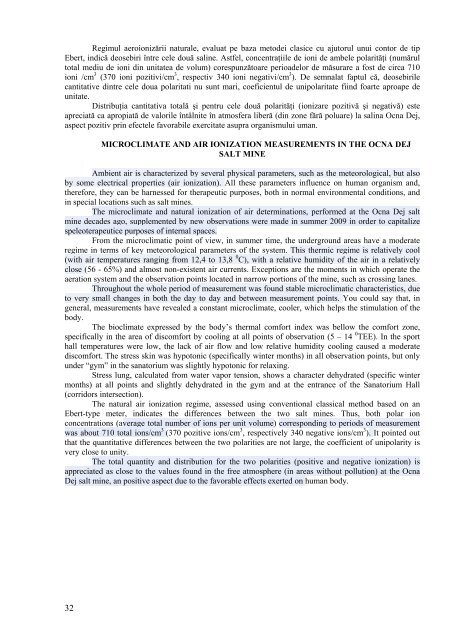BALNEO-RESEARCH JOURNAL - Asociatia Romana de Balneologie
BALNEO-RESEARCH JOURNAL - Asociatia Romana de Balneologie
BALNEO-RESEARCH JOURNAL - Asociatia Romana de Balneologie
You also want an ePaper? Increase the reach of your titles
YUMPU automatically turns print PDFs into web optimized ePapers that Google loves.
Regimul aeroionizării naturale, evaluat pe baza meto<strong>de</strong>i clasice cu ajutorul unui contor <strong>de</strong> tip<br />
Ebert, indică <strong>de</strong>osebiri între cele două saline. Astfel, concentraţiile <strong>de</strong> ioni <strong>de</strong> ambele polarităţi (numărul<br />
total mediu <strong>de</strong> ioni din unitatea <strong>de</strong> volum) corespunzătoare perioa<strong>de</strong>lor <strong>de</strong> măsurare a fost <strong>de</strong> circa 710<br />
ioni /cm 3 (370 ioni pozitivi/cm 3 , respectiv 340 ioni negativi/cm 3 ). De semnalat faptul că, <strong>de</strong>osebirile<br />
cantitative dintre cele doua polaritati nu sunt mari, coeficientul <strong>de</strong> unipolaritate fiind foarte aproape <strong>de</strong><br />
unitate.<br />
Distribuţia cantitativa totală şi pentru cele două polarităţi (ionizare pozitivă şi negativă) este<br />
apreciată ca apropiată <strong>de</strong> valorile întâlnite în atmosfera liberă (din zone fără poluare) la salina Ocna Dej,<br />
aspect pozitiv prin efectele favorabile exercitate asupra organismului uman.<br />
MICROCLIMATE AND AIR IONIZATION MEASUREMENTS IN THE OCNA DEJ<br />
SALT MINE<br />
Ambient air is characterized by several physical parameters, such as the meteorological, but also<br />
by some electrical properties (air ionization). All these parameters influence on human organism and,<br />
therefore, they can be harnessed for therapeutic purposes, both in normal environmental conditions, and<br />
in special locations such as salt mines.<br />
The microclimate and natural ionization of air <strong>de</strong>terminations, performed at the Ocna Dej salt<br />
mine <strong>de</strong>ca<strong>de</strong>s ago, supplemented by new observations were ma<strong>de</strong> in summer 2009 in or<strong>de</strong>r to capitalize<br />
speleoterapeutice purposes of internal spaces.<br />
From the microclimatic point of view, in summer time, the un<strong>de</strong>rground areas have a mo<strong>de</strong>rate<br />
regime in terms of key meteorological parameters of the system. This thermic regime is relatively cool<br />
(with air temperatures ranging from 12,4 to 13,8 0 C), with a relative humidity of the air in a relatively<br />
close (56 - 65%) and almost non-existent air currents. Exceptions are the moments in which operate the<br />
aeration system and the observation points located in narrow portions of the mine, such as crossing lanes.<br />
Throughout the whole period of measurement was found stable microclimatic characteristics, due<br />
to very small changes in both the day to day and between measurement points. You could say that, in<br />
general, measurements have revealed a constant microclimate, cooler, which helps the stimulation of the<br />
body.<br />
The bioclimate expressed by the body’s thermal comfort in<strong>de</strong>x was bellow the comfort zone,<br />
specifically in the area of discomfort by cooling at all points of observation (5 – 14 0 TEE). In the sport<br />
hall temperatures were low, the lack of air flow and low relative humidity cooling caused a mo<strong>de</strong>rate<br />
discomfort. The stress skin was hypotonic (specifically winter months) in all observation points, but only<br />
un<strong>de</strong>r “gym” in the sanatorium was slightly hypotonic for relaxing.<br />
Stress lung, calculated from water vapor tension, shows a character <strong>de</strong>hydrated (specific winter<br />
months) at all points and slightly <strong>de</strong>hydrated in the gym and at the entrance of the Sanatorium Hall<br />
(corridors intersection).<br />
The natural air ionization regime, assessed using conventional classical method based on an<br />
Ebert-type meter, indicates the differences between the two salt mines. Thus, both polar ion<br />
concentrations (average total number of ions per unit volume) corresponding to periods of measurement<br />
was about 710 total ions/cm 3 (370 pozitive ions/cm 3 , respectively 340 negative ions/cm 3 ). It pointed out<br />
that the quantitative differences between the two polarities are not large, the coefficient of unipolarity is<br />
very close to unity.<br />
The total quantity and distribution for the two polarities (positive and negative ionization) is<br />
appreciated as close to the values found in the free atmosphere (in areas without pollution) at the Ocna<br />
Dej salt mine, an positive aspect due to the favorable effects exerted on human body.<br />
32

















